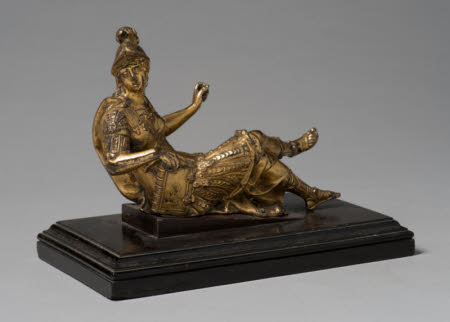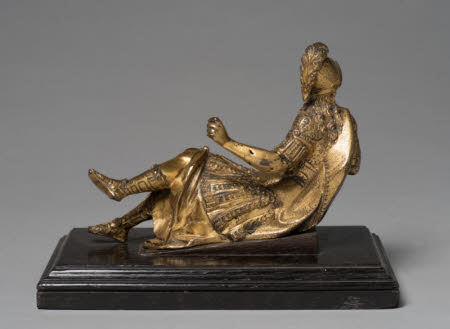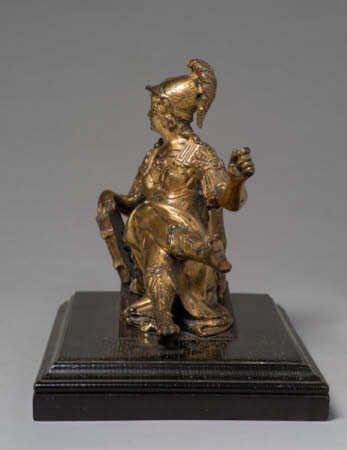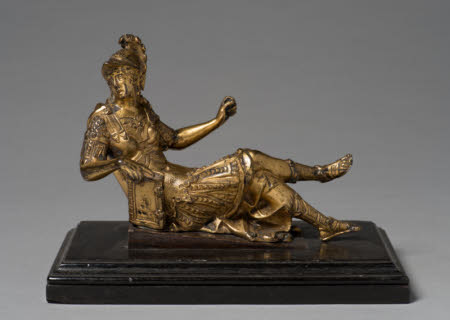Minerva
Italian (Venetian) School
Category
Art / Sculpture
Date
c. 1600 - 1650
Materials
Gilt bronze
Measurements
360 x 130 x 275 mm
Place of origin
Venice
Order this imageCollection
Anglesey Abbey, Cambridgeshire
NT 515009
Summary
Gilt bronze, Minerva, Italian (Venetian) School, c. 1600-50. A gilt-bronze figure of a reclining woman, representing Minerva (Greek, Athena), the goddess of wisdom and learning, probably made in Northern Italy in the first half of the seventeenth century. She is helmeted and dressed in armour, with a skirt-type garment covering her right leg. Her legs are crossed nonchalantly; she looks out behind her to her right, her right hand resting on a bound volume. She originally held a lance in her left hand. The surface is extensively worked with punching, e.g. on the book and the cloak. Probably from the pediment of a cabinet.
Full description
This spirited figure of the goddess Minerva was probably made as a fitting for a large cabinet, where it would no doubt have surmounted the pediment. It would almost certainly have been paired with another reclining figure, perhaps the god of war Mars, or the sun god Apollo. The depiction of Minerva in armour in a vaguely antique style is conventional, but the figure is more distinctive for its strong contrapposto pose, in which the body twists along a line from Minerva’s dangling right leg to her turned head. In this, it is reminiscent of bronze figures produced in the late sixteenth- and early-seventeenth century workshops in Venice. It compares very well with a pair of standing andiron figures of Minerva and Mars in the Kunsthistorisches Museum (Leo Planiscig, Die Estensische Kunstsammlung. I. Skulpturen und Plastiken des Mittelalters und der Renaissance, Vienna 1919, pp. 135-36, nos. 107-08; Italienische Kleinplastiken, Zeichnungen und Musik der Renaissance, Waffen des 16. und 17. Jahrhunderts, exh. cat., Schloss Schallaburg 1976, p. 117, nos. 173-74). These are broadly derived from the allegorical figures of Athena and War by Girolamo Campagna (1549-1625) in the Sala delle quattro Porte of the Doge’s Palace in Venice, made between 1584-89 (Wladimir Timofiewitsch, Girolamo Campagna. Studien zur venezianischen Plastik um das Jahr 1600, Munich 1972, pp. 248-49, no. 8, figs. 30-33). Other similarly free, rather decorative figures made in Venice around 1600 include a bronze Emperor in all-antica armour once in a Viennese private collection (Leo Planiscig, Venezianische Bildhauer, Vienna 1921, pp. 621, 625, Abb. 701, attributed to the workshop of Nicolò Roccatagliata (active 1593-1636)), and a statuette of Abundance in the Museo Civico Amedeo Lia, La Spezia (Charles Avery, La Spezia, Museo Civico Amedeo Lia. Sculture. Bronzetti, Placchette, Medaglie, La Spezia 1998, pp. 166-67, no. 99, as Venice, late 16th century). The Anglesey Abbey Minerva fits well into this context, so seems likely to be the work of a secondary Venetian workshop active around 1600 or a little into the 17th century. Whilst clearly in the general style of sculptors such as Girolamo Campagna, Tiziano Aspetti (cf. his Apollo at Anglesey Abbey, NT 515026) or Nicolò Roccatagliata, it is not possible to attribute a fairly minor work like this to a specific sculptor. A second version of the model was recently offered for sale at Sotheby’s London (Old Master Sculpture and Works of Art, 3 July 2018, lot 75, unsold), where it was described as Venetian early seventeenth-century work, from the circle of Roccatagliata. Jeremy Warren 2019
Provenance
Purchased by Urban Huttleston Rogers Broughton, 1st Lord Fairhaven (1896-1966); bequeathed to the National Trust by Huttleston Rogers Broughton, 1st Lord Fairhaven (1896-1966) with the house and the rest of the contents.
Credit line
Anglesey Abbey, The Fairhaven Collection (The National Trust)
Makers and roles
Italian (Venetian) School , sculptor
References
Christie, Manson & Woods 1971: The National Trust, Anglesey Abbey, Cambridge. Inventory: Furniture, Textiles, Porcelain, Bronzes, Sculpture and Garden Ornaments’, 1971, p. 130, First Strong Room






